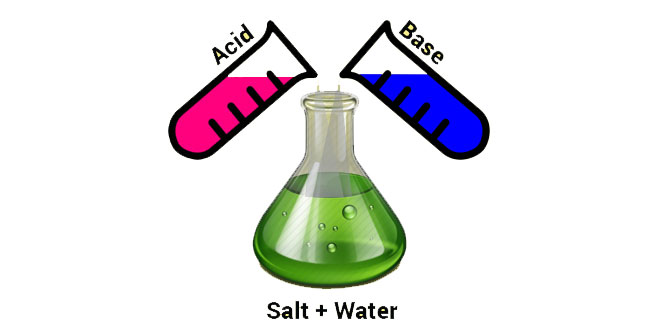Question: What is meant by p and pH?
Answer: p in pH stands for ‘potenz’ in Germany and H is for hydrogen.
Question: What are antacids? Explain their role in providing relief from stomach ache.
Answer:
- Antacids are mild base.
- Antacids neutralise the effect of extra acid produced in the stomach during indigestion and thus provide relief.
Question: How does the change occur in values of milk when it changes to curd?
Answer: When milk changes to curd, it becomes acidic due to the formation of lactic acid. Thus, its pH value decreases and becomes less than 6.
Question: Define alkalies and give an example.
Answer: The bases soluble in water are called alkalies. e.g., NaOH, KOH.
Question: Mention the range of pH value for a identification of a base.
Answer: pH value for identification of a base is 7-14.
Question: How chloride of lime differs chemically from calcium chloride?
Answer: Chloride of lime is CaOCl2 while calcium chloride is CaCl2.
Question: What is meant by “water of crystallization” in a substance? Explain with an example.
Answer: Water of crystallization the fixed number of water molecules present in one formula unit of a salt.
Example: Hydrated copper sulphate (CuSO4.5H2O). Here, 5H2O signify five molecules of water of crystallization.
Question: Write the chemical name and chemical formula of washing soda.
Answer: Chemical name: Sodium carbonate
Chemical formula: Na2CO3.10H2O
Question: What effect does an increase in concentration of H+(aq) in a solution have on the pH of solution?
Answer: The pH of a solution decrease with the increase in the concentration of H+(aq) in a solution. More are the H+(aq) in a solution, more is the acidity, and less is the pH value of that solution.
Question: Name the gas evolved when dilute HCl reacts with sodium hydrogen carbonate. How is it recognized?
Answer: The gas evolved is CO2. When this gas is passed through lime water, it turns it milky.
Question: What are olfactory indicators?
Answer: The substances whose odour changes in acidic or basic media are called olfactory indicators.
Question: Why does 1 MHCl solution have a high concentration of H+ ions than 1 M CH3COOH solution?
Answer: HCl solution is a strong acid and, therefore, ionises completely as compared to CH3COOH solution which is a weak acid. Due to complete ionisation, it contains high concentration of H+ ions. 2
Question: Which one of the following has a higher concentration of H+ ions? 1 M HCl or 1 M CH3COOH.
Answer: 1 M HCl has higher concentration of H+ ions. Being strong acid, it ionises completely to furnish H+ ions.
Question: How will you test for the gas which is liberated when hydrochloric acid reacts with an active metal?
Answer: When burning candle is brought near to the jar filled with hydrogen gas, it burns explosively with a pop sound.
Question: In which form H+(hydrogen) ions exist in water?
Answer: Since hydrogen ions cannot exist alone, therefore, they exist after combining with water molecules. Thus, hydrogen ions must be shown as H+ (aq) or hydronium ion (H3O+).
Question: How is the pH of a solution of an acid influence when it is diluted?
Answer: On dilution, the concentration of hydrogen ions per unit volume decreases and hence pH of the solution increases. Since pH is the negative logarithmic value of the concentration of hydrogen ions.
Question: At what pH rain water is said to be acidic?
Answer: When pH of rain water is less than 5.6, then it is called acid rain.
Question: Which gas is evolved when dilute hydrochloric acid reacts with zinc? Write the molecular formula of this gas.
Answer: Hydrogen gas. Molecular formula is H.
Question: Dry HCl gas does not change the colour of dry litmus. Give reason.
Answer: H+ ion from HCl cannot ionise to give H+ ions in absence of water. Acidic property like change in colour of litmus depends on production of H+ ion, hence there is no colour change.
Question: Why is HCl a stronger acid than acetic acid?
Answer: On dissociation, it yields larger [H+] Hydrogen ions for the same concentration as compared to acetic acid.
Question: Tooth enamel is the hardest substance in our body. Name the compound of which it is made-up of. At what pH of the mouth it gets corroded? State the role of bacteria present in the mouth. Suggests a method to present tooth decay.
Answer: Calcium phosphate; below 5.5; bacteria produce acids by degradation of sugar and food particles remaining in the mouth after eating; using tooth pastes which are generally basic.
 Class Notes NCERT Solutions for CBSE Students
Class Notes NCERT Solutions for CBSE Students





